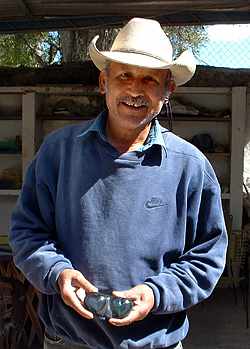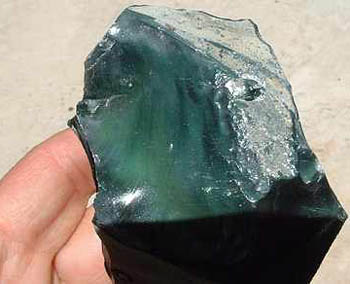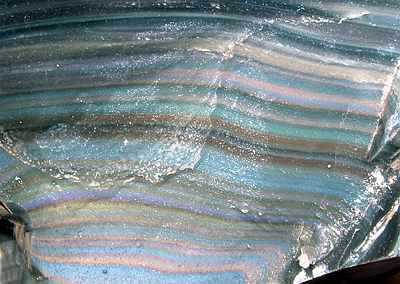 |
 |
“I’m going to take you to the obsidian workshop of Navajas so you can see with your own eyes what these humble people are doing,” declared our friend Pedro Fernández Somellera, a good friend who always seems to be involved in ten different projects at the same time.
True to his word, one day Pedro drove us past the sugar refinery of Tala—located west of Guadalajara, Mexico’s second-biggest city—along a desolate country road to a sign announcing the little town of Navajas, which means “knives” in Spanish. There was nothing on the sign indicating that here one could find a workshop capable of producing art much appreciated in Paris (and I don’t mean Texas!).
|
Weaving his way through the rather haphazardly-oriented
cobblestone streets of Navajas, Pedro came to a stop in front of a doorway below
a sign reading “Empresa de Solidaridad” (Business created in the name of
Solidarity) which indicated little of what might go on inside. However, the
large chunks of roughly hewn obsidian on both sides of
the doorway indicated that we were at the right place...
|
 |
“Eleno Espinoza and his brother started this workshop eleven years ago,” said Pedro. “They were both miners back then and let me tell you, in my opinion, mining is not a profession—it’s a sickness.”
A sickness akin to gambling, I thought to myself. Good for the Espinoza brothers to have tried something different!
Inside, we shook hands with Don Eleno, one of those unprepossessing Mexicans of humble origin who, you could immediately feel, would give the shirt off his back and his sombrero as well, to help out a friend and perhaps even an enemy. Yes, Don Eleno’s amabilidad shown brightly in his eyes and later Pedro told us that plenty of unscrupulous types had taken advantage of this over the years.
Don Eleno introduced us to his workers and soon a big man named Manuel was showing us the various kinds of obsidian they use as their raw material.
“This is red obsidian or sangre de Indio, (Indian’s blood)” said Manuel, showing us a beautiful mixture of red, black and shades of brown that I would never have associated with obsidian at all. “This stuff comes from a nearby hill owned by our ejido, (local campesinos’ cooperative)” said Manuel, “and we trade some of it for other obsidians. There’s black, of course, which is the most common and the greenish obsidian you brought us from the mine you explored (See The Creepy-Crawly, Creamy-Green Obsidian Mine). But take a look at this.”
He held out a slab of black which, when slightly turned in the sunlight, shimmered as if it had been spray painted with gold. Another one had the sheen of gleaming silver. Yet another had a bright kryptonite-green glow that seemed to come from deep inside. But the raw rock that sent us into raptures was called “rainbow obsidian” and displayed every color of the spectrum as you turned it in the sunlight.
 
Left: obsidian with a deep, green glow
Right: rainbow obsidian |
So what were these humble artisans turning this wonderful raw material into?
“Hearts and butterflies, just like everybody else,” said Pedro wistfully. “That was before I met them, but I had a feeling they could do a whole lot better than that, so I began bringing some really talented Mexican sculptors here, to show them other possibilities. These artists brought clay models of their works and Eleno’s craftsmen proved they could reproduce them in this incredible medium, in these fascinating varieties of obsidian. Some of those pieces were sold for thousands of dollars in Paris.”
When we first walked into the workshop, I looked around and asked myself, “Where is it that they do the sculpting?” One half the room is filled with belt-driven wheels and disks which I assumed were for polishing. Instead, it turned out that most of these were grinding wheels where a misshapen lump could become an objet d’art (in the right hands)...
|
Pedro is now arranging for a show of Don Eleno’s best work
in Guadalajara. Getting the Navajas artisans to work on these pieces instead of
on hearts and butterflies, tests his patience and sometimes leaves him
depressed. But I think if we have any hope at all for a better world, it’s
because of the simplicity of people like Don Eleno and the vision and
persistence of people like Pedro Fernández Somellera.
|
 |
HOW TO GET THERE
If you live near Guadalajara, why don't you stop in to see the Obsidian Workshop? They almost always have something new lying about on the dusty tables and shelves around the work area and you are bound to get a good bargain.
Navajas is smack in the middle of a country road linking Tala and Santa Cruz, which means it can easily be reached both from highway 90 leading to Ameca or highway 54 leading to Colima. Because the Santa-Cruz-Tala road is the continuation of the Tlajomulco road, people living near Lake Chapala can get there a whole lot easier than those living in Guadalajara. Just head for Tlajomulco and keep going northwest. For further reference, Navajas is between the towns of Ahuisculco and San Isidro Mazatepec.
When you leave the highway, follow the cobblestones into Navajas. When you come to a big Y, take the left fork which puts you on Benito Juarez Street. Now go southeast 260 meters and turn right, just before the school. You’ll see the workshop just ahead on the left side of the street. If you have a GPS, you’ll find Don Eleno’s Taller de Obsidiana at exactly N 20 degrees 31’ 58.3”, W 103 degrees, 40’ 39.1”. Total driving time from the Guadalajara Periférico: about 50 minutes.
John Pint